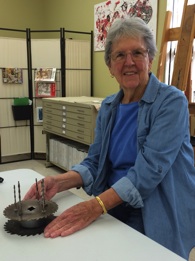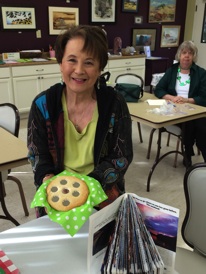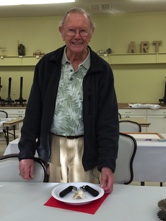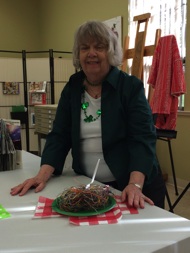NEW CONTROVERSIAL ARTWORKS ON DISPLAY
By Diane Dathe
Referred to as the “Square Pegs,” students participating in an Independent Masters Study Group prefer to focus on the non-traditional and more provocative styles of art.
The group's leader, Jim Paradis, encourages his followers to find their own way, as he presents the art periods and styles they study as guidance and inspiration.† The students are encouraged to learn the past, be inspired by it, but ultimately make their art, their own.
The latest project taken on by the Square Pegs was inspired by the highly controversial period known as Dada.
Dada was born out of negative reactions to the horrors of World War I.† It was an international movement begun by a group of artists and poets.† The movement channeled its anti-war politics through a rejection of the prevailing standards in art, through anti-art cultural works.† The Dadaists believed that reason, logic and cultural norms had led the people to war, and, as a protest, they rejected those tenets and embraced chaos and irrationality through their art.
The Square Pegs' 3-dimensional artworks are on display in the Arts and Crafts Art Room, located at Cribari Center next door to the Woodshop.
Once you've seen the artworks, be sure to let them know how much you hate it!
Dada and Beyond with Professor H. James Paradis
Dada (/\ˈdɑːdɑː/) or Dadaism was an art movement of the European avant-garde in the early 20th century. Dada in Zurich, Switzerland, began in 1916, spreading to Berlin shortly thereafter, but the height of New York Dada was the year before, in 1915.[1] The term anti-art, a precursor to Dada, was coined by Marcel Duchamp around 1913 when he created his first readymades.[2] Dada, in addition to being anti-war, created social and political criticism.
The roots of Dada lay in pre-war avant-garde. Cubism and the development of collage, combined with Wassily Kandinsky's theoretical writings and abstraction, detached the movement from the constraints of reality and convention. The influence of French poets and the writings of German Expressionists liberated Dada from the tight correlation between words and meaning.[4] Avant-garde circles outside of France knew of pre-war Parisian developments. They had seen (or participated in) the Armory show in New York (1913) and others in Europe. Futurism developed in response to the work of various artists. Dada subsequently combined these approaches.[5]
According to Hans Richter Dada was not art: it was "anti-art."[6] Dada represented the opposite of everything which art stood for. Where art was concerned with traditional aesthetics, Dada ignored aesthetics. If art was to appeal to sensibilities, Dada did not.
As Hugo Ball expressed it, "For us, art is not an end in itself ... but it is an opportunity for the true perception and criticism of the times we live in."[8]
Now we are working on Dada……and Beyond!
"Foolery, sir, does walk about the orb like the sun. It shines everywhere."
William Shakespeare, The Comedy of Errors
DADA
Independent Study Group with Professor Jim Paradis
The Square Pegs
Art is not a job or a skill. It is a way of walking through life.
A different way of looking at art: studying the different genres and movements in art by creating paintings or sculpture in the manner of the genre or period.







